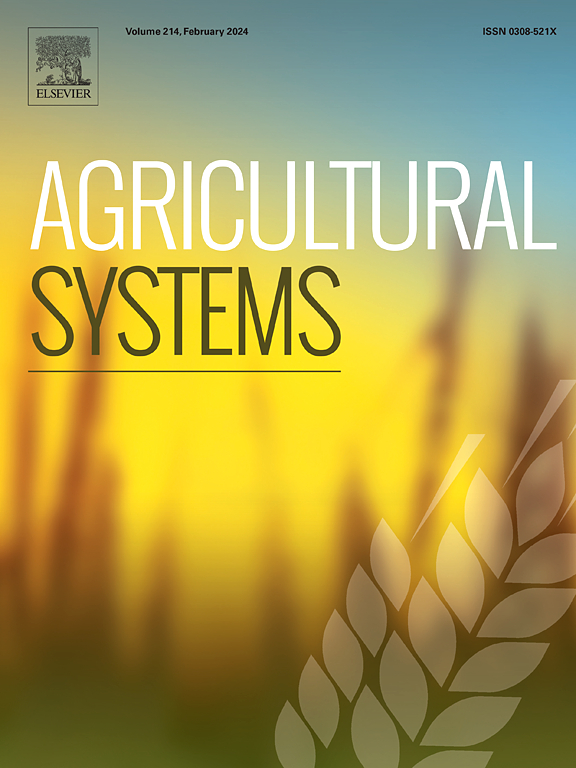Can trees and their associated organisms still benefit arable crops in the presence of pesticide use?
IF 6.1
1区 农林科学
Q1 AGRICULTURE, MULTIDISCIPLINARY
引用次数: 0
Abstract
CONTEXT
Trees growing in and around the field (agroforestry) attract a range of organisms and empirical studies indicate that these are overall beneficial to the arable crop. A recently modelling study of English organic silvoarable using a new approach based on Boolean regulatory network modelling supported this conclusion.
OBJECTIVE
Here we develop this model further to consider the impact of pesticide use on the benefits trees can bring to crops through living interactions.
METHODS
Pests in the model agroecosystem are selectively and non-selectively removed from the agroecosystem under a range of intervention thresholds to simulate pesticide use, and the benefits of trees quantified and compared to benefits accrued under a baseline treatment of no pesticide use.
RESULTS AND CONCLUSIONS
Selective interventions for crop disease and crop insects (pests and non-target natural enemies) dramatically reduce the benefits of trees, even at relatively high intervention thresholds. Intervention for crop weeds increases the benefits of trees, as weeds are often considered a burden associated with tree understories. Less selective, double interventions (weed-disease, weed-pest-natural enemy, disease-pest-natural enemy) all reduce the benefits of trees, but the weed-pest-natural enemy intervention least so. Unsurprisingly, removing all living associates of trees renders trees of no benefit to crop yield through biotic mechanisms but, more surprisingly, this conclusion applies when intervention thresholds are high and delayed to late in the growing season.
SIGNIFICANCE
Caution is urged in the interpretation of model findings but this study provides a first guide to how pesticide use in agroforestry systems modulates the benefits of trees. These findings may be particularly useful to growers in the increasingly popular area of regenerative agriculture which permits restrained and selective use of pesticides.

在使用农药的情况下,树木及其相关生物是否仍能使耕地作物受益?
生长在田间及其周围的树木(农林业)吸引了一系列生物,实证研究表明,这些对可耕地作物总体上是有益的。最近,一项基于布尔调节网络建模的新方法对英国有机硅藻土的建模研究支持了这一结论。目的进一步发展该模型,以考虑农药使用对树木通过生物相互作用给作物带来的效益的影响。方法在模拟农药使用的一系列干预阈值下,将模型农业生态系统中的有害生物选择性和非选择性地从农业生态系统中去除,并将树木的效益量化,并与不使用农药的基线处理下产生的效益进行比较。结果与结论即使在较高的干预阈值下,对作物病虫害(害虫和非目标天敌)的选择性干预也会显著降低树木的效益。对作物杂草的干预增加了树木的效益,因为杂草通常被认为是与树木林下植被有关的负担。选择性较低的双重干预(杂草-疾病、杂草-害虫-天敌、病虫害-天敌)都会降低树木的效益,但杂草-害虫-天敌干预的影响最小。不出所料,通过生物机制去除树木的所有活的伙伴对作物产量没有任何好处,但更令人惊讶的是,当干预阈值很高且延迟到生长季节后期时,这一结论适用。对模型结果的解释需要谨慎,但本研究为农林业系统中农药的使用如何调节树木的效益提供了第一个指南。这些发现可能对日益流行的可再生农业领域的种植者特别有用,可再生农业允许有节制和选择性地使用农药。
本文章由计算机程序翻译,如有差异,请以英文原文为准。
求助全文
约1分钟内获得全文
求助全文
来源期刊

Agricultural Systems
农林科学-农业综合
CiteScore
13.30
自引率
7.60%
发文量
174
审稿时长
30 days
期刊介绍:
Agricultural Systems is an international journal that deals with interactions - among the components of agricultural systems, among hierarchical levels of agricultural systems, between agricultural and other land use systems, and between agricultural systems and their natural, social and economic environments.
The scope includes the development and application of systems analysis methodologies in the following areas:
Systems approaches in the sustainable intensification of agriculture; pathways for sustainable intensification; crop-livestock integration; farm-level resource allocation; quantification of benefits and trade-offs at farm to landscape levels; integrative, participatory and dynamic modelling approaches for qualitative and quantitative assessments of agricultural systems and decision making;
The interactions between agricultural and non-agricultural landscapes; the multiple services of agricultural systems; food security and the environment;
Global change and adaptation science; transformational adaptations as driven by changes in climate, policy, values and attitudes influencing the design of farming systems;
Development and application of farming systems design tools and methods for impact, scenario and case study analysis; managing the complexities of dynamic agricultural systems; innovation systems and multi stakeholder arrangements that support or promote change and (or) inform policy decisions.
 求助内容:
求助内容: 应助结果提醒方式:
应助结果提醒方式:


